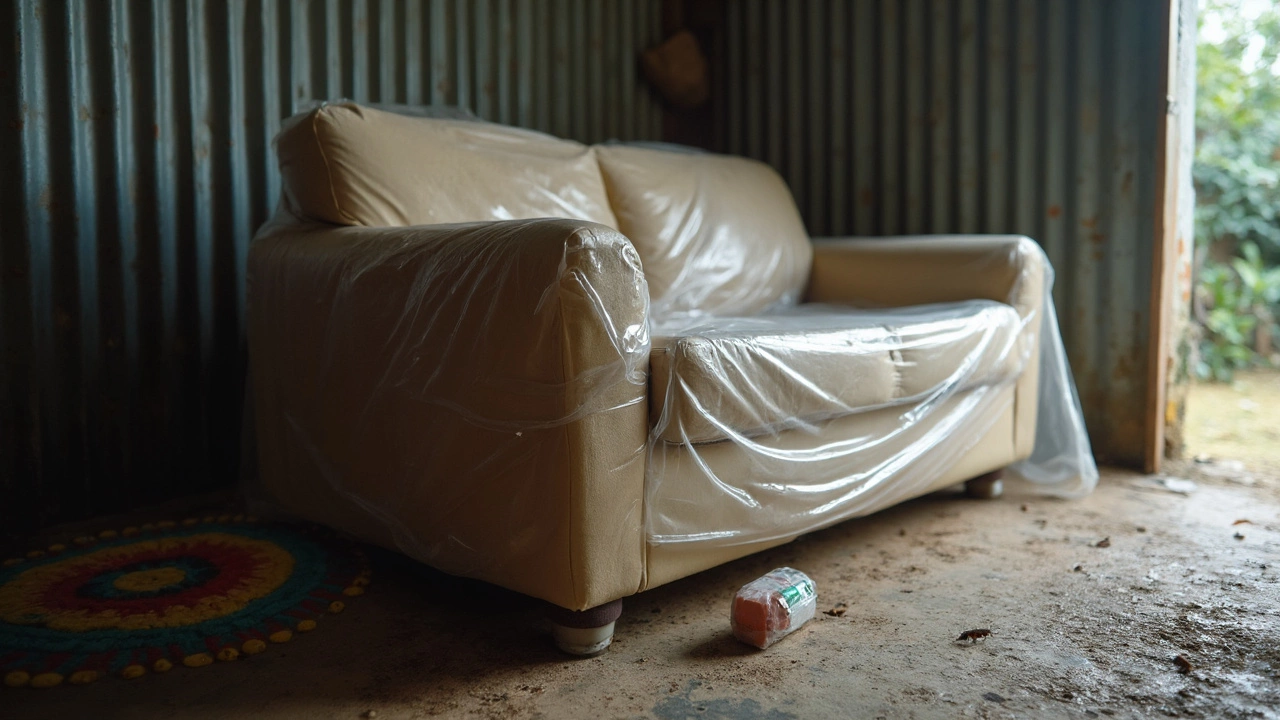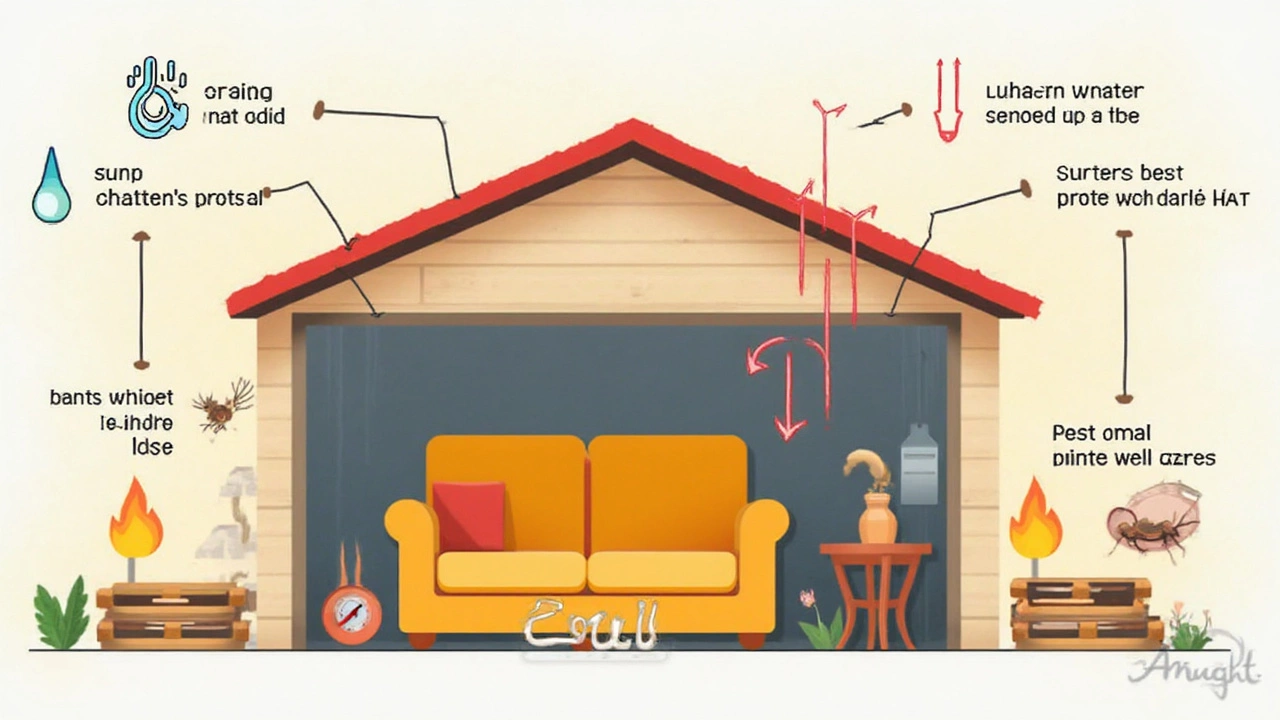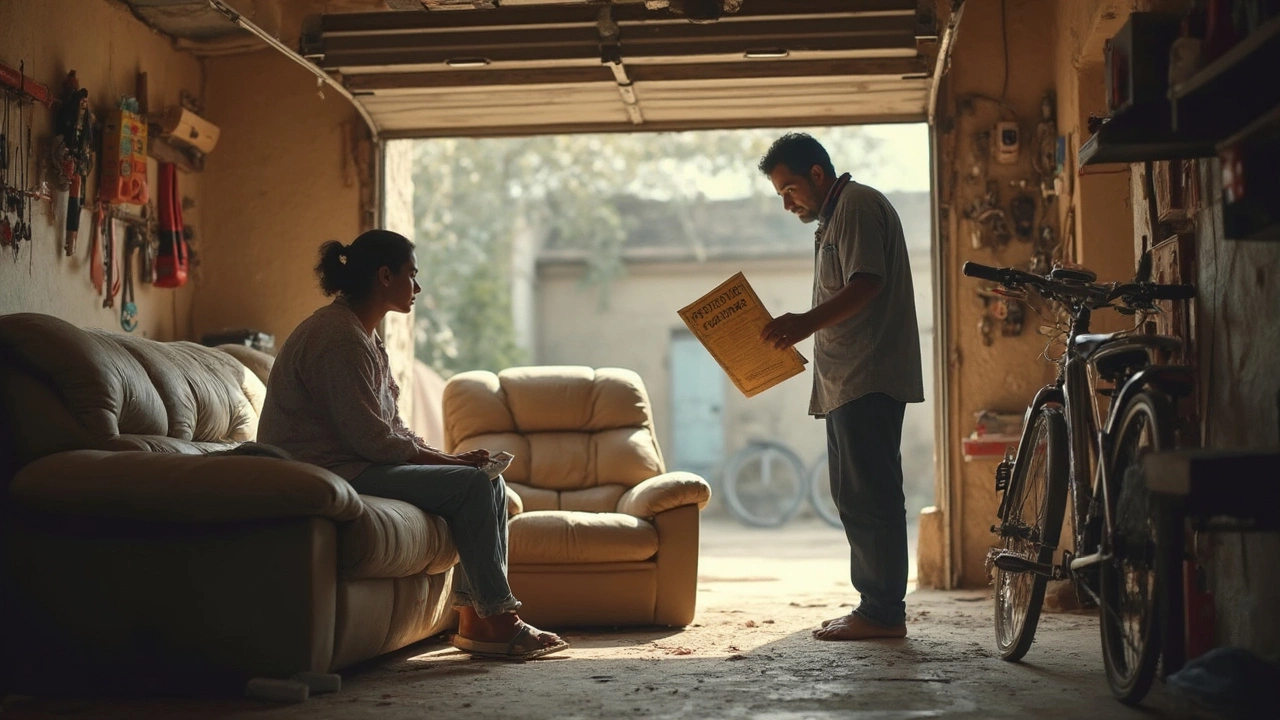You’ve got an extra couch. The living room’s maxed out, so the garage seems like an obvious solution, right? Before you shove it next to your lawnmower, it’s worth knowing that garages aren’t actually made for furniture storage. They’re usually not insulated, which means your couch is at the mercy of swings in temperature and humidity.
Loads of people quickly regret storing a sofa in a garage because it turns into a magnet for dust, pests, and even mold. Why? Because most garages get humid, and that’s a perfect recipe for smelly, damaged upholstery or warped wood. Want your couch to actually survive its time in storage? You’ll need to think a bit beyond tossing on a sheet and calling it good.
There are ways to lower the risks and keep your couch in halfway decent shape, like using protective covers and finding ways to control the air (think dehumidifiers or silica packets). Not all couches are equal, either. A leather couch reacts differently than that hand-me-down floral one from your grandma. Let’s look at what you’re really up against and what you can do if the garage is your only shot at hanging onto your extra seating.
- Why People Store Couches in the Garage
- Hidden Dangers: What Happens to Couches in Garages
- Garage-Proofing Your Couch: Practical Tips
- Signs You Shouldn’t Store Your Couch in the Garage
- Alternatives and When to Rethink
Why People Store Couches in the Garage
Let’s be real: garages quickly turn into overflow zones for all kinds of stuff we don’t have space for in the house. That includes old or extra couches. Space in a garage comes in handy, especially if you just bought a new sofa and haven’t decided what to do with the old one yet. Or maybe you’re moving, remodeling, or saving a couch for a friend or family member. It feels like a safe, “out of the way” spot.
Many folks turn to this solution after running out of basement or attic space, or when there’s a short window between a big change—like a renovation or someone moving out. Plus, hiring a storage unit costs money you might want to save for other things.
| Reason | How Common (%) |
|---|---|
| No space inside the house | 44% |
| Between moves/renovations | 29% |
| Saving for sale or giveaway | 13% |
| Temporary convenience | 10% |
| Other | 4% |
People also assume a garage keeps things safe from rain, direct sun, or prying eyes. It gives you the illusion of control because you can throw a cover on, tuck it away, and forget about it—at least for a while. It’s a little like shoving laundry in a closet before company arrives.
But here’s the main catch: just because the garage seems like a handy fix, it doesn’t always play nice with your couch storage plans. Before you use the garage as a storage answer, it helps to understand what’s actually happening with temperature, humidity, and space in there.
Hidden Dangers: What Happens to Couches in Garages
A garage isn’t just an oversized closet. Most garages don’t have climate control, so anything you toss in there—especially a couch—gets exposed to some pretty rough conditions. Think about summer heat waves where the temperature inside can shoot up past 100°F, and winters where it drops below freezing. All these swings can mess up the frame, padding, and especially the upholstery of your couch.
| Garage Condition | Impact on Couch |
|---|---|
| High Humidity | Moldy cushions, musty smell, wood warping |
| Temperature Swings | Cracked leather or vinyl, weakened frame glue |
| Pests (mice, bugs) | Chewed fabric, droppings, infestations |
| Dirt & Dust | Dingy, hard-to-clean fabric |
Humidity is enemy number one. Couches are basically sponges for moisture. If the humidity sticks around, you could open your garage one day and get hit with a nasty whiff—yep, that’s mold. According to the Environmental Protection Agency, anything above 60% humidity is a sweet spot for mold to start growing. That’s rough news because lots of garages hit those levels in certain seasons.
Pests are a whole other problem. Mice, spiders, and bugs just love dark, undisturbed couches. They burrow into the cushions, chew up the stuffing, and leave droppings behind. Bug sprays won’t fix the damage from gnawing or droppings buried deep in your sofa.
Temperature spikes are not just uncomfortable for you—it’s brutal for your couch. Wood frames loosen up and then contract, which eventually leads to creaks or even cracks. Leather or vinyl? They’ll dry out and crack, sometimes beyond repair. Fabric tends to fade or get brittle. As one home storage expert from The Spruce points out:
“Storing furniture in the garage exposes it to fluctuating temperatures and moisture, which can wreak havoc on wood and fabric within months.”
If you’ve got a soft spot for your couch storage plans, these threats are no joke. It’s not just about a little dust; real damage can pop up in less than a season.

Garage-Proofing Your Couch: Practical Tips
Storing a couch in the garage sounds easy until you realize how rough that environment can be. But it’s not all doom and gloom—there’s a way to give your couch some real protection. Here are some straightforward tips that actually work.
- Lift It Off the Ground: Place your couch on wooden pallets, bricks, or sturdy plastic risers. This keeps it away from damp concrete and puddle-prone floors. My buddy once skipped this step and his couch legs swelled up and turned mushy after a rainy spring. Lesson learned!
- Wrap It Up Right: Use breathable furniture covers (not plastic!) to shield your couch from dust while letting moisture escape. Plastic traps humidity and is a fast track to mold city. If you don’t have a furniture cover, even a couple of old clean sheets can help.
- Dehumidify the Space: Moisture = enemy number one. A basic plug-in dehumidifier or even moisture-absorbing silica packs can keep your garage air drier. If you live somewhere muggy—say, Houston in August—this step is non-negotiable.
- Pest-Proof Like a Pro: Rodents and bugs love garages. Use pest repellents (like cedar blocks or peppermint oil), and check for gaps around doors where critters sneak in. My cat Whiskers once left a dead mouse inside my garage couch—not where you want any surprises!
- Check Regularly: Pop in every few weeks to look for early problems. If you spot moisture, bugs, or smells, fix it fast before things go downhill.
You might be wondering how much these factors can actually impact your stuff. Here’s a comparison you may find eye-opening:
| Garage Condition | Chance of Couch Damage (6 months) |
|---|---|
| Uninsulated, high humidity | 70% |
| Uninsulated, with precautions | 40% |
| Insulated, well-sealed, climate control | 10% |
Bottom line? The better you prep your garage and couch, the longer it’ll last. Your future self (and maybe your next Netflix binge) will thank you.
Signs You Shouldn’t Store Your Couch in the Garage
Not every garage is couch-friendly—and some couches just aren’t cut out for harsh storage, no matter what you do. It’s pretty easy to miss the red flags at first, but here’s what to watch out for before dragging in your old sofa.
- Humidity off the charts: If your garage smells musty or you can spot water spots after rain, you’re looking at prime territory for mold and mildew. Upholstery, especially foam, loves to soak up moisture—and it’s almost impossible to get rid of that funky smell once it sets in.
- Major temperature swings: Garages that get freezing in winter and brutal in summer will punish your cushions and framing. Wood can warp, leather will crack, and even synthetic fabrics start to break down. If your state’s known for wild weather, think twice.
- Pest problems: You’ve seen mouse droppings or piles of dead bugs in the corners? Pests see that couch as a new hotel. Rodents love tearing into fabric for nesting, and insects can easily infest the stuffing.
- No insulation or sealing: Gaps under the garage door or old windows mean more dust, debris, and even more bugs. Air leaks also make controlling humidity or temperature a losing battle.
- Specialty couches: Anything vintage, delicate, or worth serious money shouldn’t go anywhere near a garage. The risk just isn’t worth it for stuff that’s impossible to replace.
Still unsure? Here’s a quick look at problems people usually face when they try to store a couch in a garage:
| Problem | What Happens? | Time It Takes |
|---|---|---|
| Mold growth | Musty smell, stains, ruined fabrics | 2-4 weeks (with high humidity) |
| Pest infestation | Chewed fabric, nests, droppings | 1-2 months |
| Wood warping | Bowed frame, wobbly legs | 1 season |
| Cracked or faded leather | Loss of color, brittle texture | 6 months |
The bottom line: if your garage is damp, full of critters, or swings wildly between hot and cold, storing a couch there is almost guaranteed to end badly. It’s usually smarter to find alternative storage or at least address these issues before risking your couch storage plan.

Alternatives and When to Rethink
If your gut is telling you that parking your couch in the garage isn't a great plan, you’re onto something. There are better ways to store your couch that can keep it in decent condition, especially if you care about it lasting more than a few months.
The first thing to ask yourself: Is your garage dry and insulated? If not, and you can't easily fix that, you might be setting yourself up for disappointment. Here’s what you can consider instead:
- Climate-controlled storage unit: These places keep humidity and temperature stable, so you don’t come back to moldy, musty fabric or cracked wood. According to the Self Storage Association, about 38% of Americans storing furniture pick climate-controlled units for just this reason.
- Find a spot indoors: Even a spare bedroom or home office corner is better than a damp garage. Basements work if they’re not musty or prone to leaks.
- Loan it to a friend: If you don’t need the couch now, maybe someone in your circle does. You both win—your couch stays in use, and your friend gets a free seat.
- Sell or donate: Sometimes, hanging onto old furniture causes more headaches than it’s worth. If space is short, listing online or donating can actually be less stress in the long run.
In some cases, garages can cause more harm than good. Not sure if the space is risky? Here’s a quick comparison of common storage options and what to look out for:
| Option | Pros | Cons |
|---|---|---|
| Garage | Easy, on-site access | No climate control, risk of pests, moisture damage |
| Climate-controlled storage | Protects from humidity, stable temps | Monthly cost, need to transport |
| Basement (dry) | Out of living space | Potential for moisture if not sealed |
| Friend/Family's house | Couch gets used, can borrow back | May be tricky to coordinate |
| Donate/Sell | Free up space, goodwill/cash | Couch is gone for good |
If you’re only storing your couch for a couple of weeks while you move or renovate, the garage might be fine in a pinch with good covers and some drying tricks. But if you’re staring at months, or your garage has even a whiff of dampness, it’s time to look elsewhere. Trust me—fixing a damaged couch costs more time and stress than moving it to a safer spot now.

